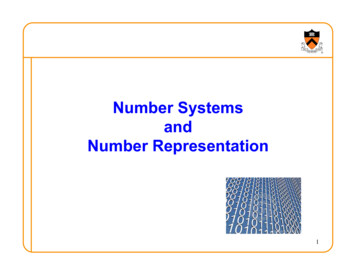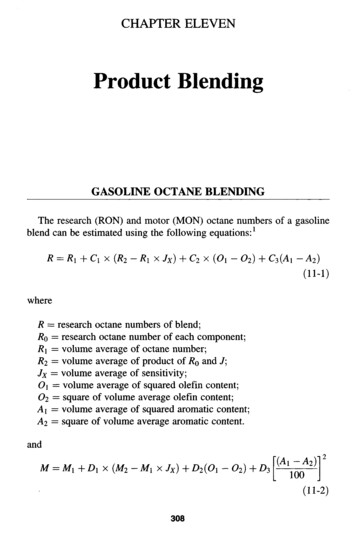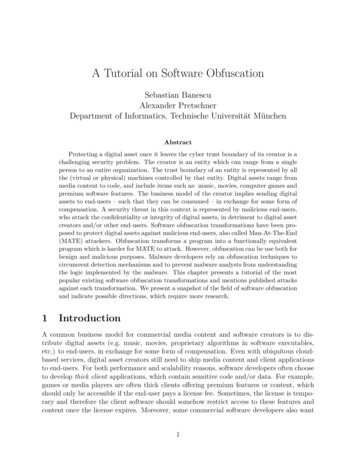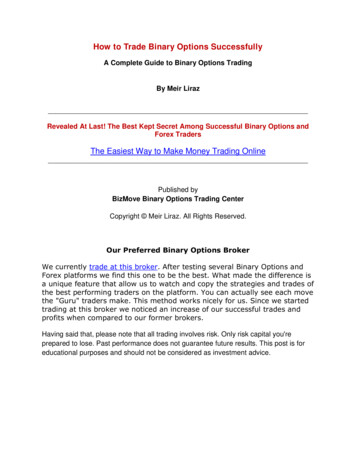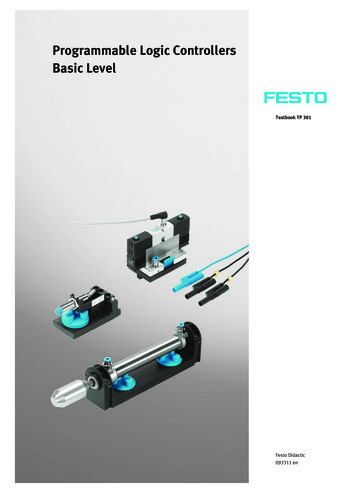
Transcription
Binary Obfuscationfrom the Top DownHow to make your compiler do your dirty work.
Binary ObfuscationWhy Top Down? Assembly, while “simple,” is tedious. It’s easier for us to write higher-level code. Some of us. Why do it by hand when you can be lazy?
Binary ObfuscationWhat’s the purpose of obfuscation? To waste time. To intimidate. To be a total jerk.
Binary ObfuscationWhat tools will be used? C and C MSVC for compilation (sorry)
Binary ObfuscationWhat will not be covered? Anti-debug Source obfuscation where it does notrelate to binary transformations Obfuscation effectiveness Post-compilation obfuscation
Important BasicsHopefully we can get through this really quickly.
Fun With Pointerscar cdr cadr cdar cdadr cdddr caar caaar caaaarcaaaaaar
Binary ObfuscationFunction Pointers Like string-format vulnerabilities, functionpointers are ancient Voodoo. I honestly don’t know who thought thesewere a good idea, but I freakin’ love ‘em. See src/funcptr.c
Binary ObfuscationFunction Pointersint foo (void) {return 949;}int bar (void) {int (*fooPtr)(void);fooPtr foo;return fooPtr();}
Binary ObfuscationMethod Pointers Abuse of method pointers would probablymake Bjarne Stroustrup really angry. There is also one thing uglier than functionpointers. That’s method pointers. See src/methodptr.cpp
Binary ObfuscationMethod Pointersint MyClass::foo(void) {return 310;}int bar (void) {MyClass baz;int (MyClass::*fooPtr)(void);fooPtr &MyClass::foo;return (MyClass.*baz)fooPtr();}
Calling ConventionsI really want to write a clever pun about payphones andDEFCON, but I just can’t.
Binary ObfuscationCalling Conventions When making a function call, there are afew ways to do it: stdcall cdecl fastcall thiscall
Binary ObfuscationCalling Conventions stdcall Push arguments onto stack Called function pops from stack Cleans up its own mess.
Binary ObfuscationCalling Conventions cdecl Push arguments onto stack Called function pops from stack Called function cleans up the mess
Binary ObfuscationCalling Conventions fastcall First two arguments less than a DWORDmoved into ecx and edx respectively Rest are pushed onto the stack Called function pops from the stack Called function cleans up the mess
Binary ObfuscationCalling Conventions thiscall Used when a function within a classobject is called “this” pointer moved into ecx Function arguments pushed onto stack Called function pops from stack Cleans up its own mess
CompilerOptimizationsThe Dragon Book: Not Just for Furries Anymore
Binary ObfuscationCompiler Optimizations Control-flow analysis Variable analysis Reach-of-use The volatile keyword
Binary ObfuscationCompiler Optimizations At compile time, your code is separatedinto multiple blocks. A “block” consists of code separated by conditional (e.g. JLE, JNE, etc.) andunconditional jumps (e.g. CALL and JMP).How this code is organized and how thejumps occur affects the optimization of theprogram.
Binary ObfuscationCompiler OptimizationsMOVXORCMPJNEz0r:XOR EAX,310PUSH EAXEAX,949EAX,310EAX,0z0rXOR EAX,949LEAVERETN
Binary ObfuscationCompiler OptimizationsMOVXORCMPJNEz0r:XOR EAX,310PUSH EAXEAX,949EAX,310EAX,0z0rlol lemmefix thisXOR EAX,949LEAVERETN
Binary ObfuscationCompiler OptimizationsMOV EAX,949XOR EAX,310XOR EAX,310PUSH EAX
Binary ObfuscationCompiler Optimizations The compiler also looks at your variables to make sure you’re not doing anythingrepetitive or inconsequential.Algorithms like the directed acyclic graph(DAG) algorithm and static variable analysismake sure memory and math are fullyoptimized.
Binary ObfuscationCompiler OptimizationsMOV EAX,949XOR EAX,310XOR EAX,310PUSH EAX
Binary ObfuscationCompiler OptimizationsMOV EAX,949XOR EAX,310XOR EAX,310PUSH EAXlol seriously?
Binary ObfuscationCompiler OptimizationsMOV EAX,949PUSH EAX
Binary ObfuscationCompiler OptimizationsMOVXORCMPJNEEAX,949EAX,310EAX,0z0rMOV EAX,949PUSH EAXz0r:XOR EAX,310PUSH EAXXOR EAX,949LEAVERETN
Binary ObfuscationCompiler Optimizations Your compiler is a neat-freak. If the compiler notices it doesn’t need avariable anymore, it’s just going to get rid ofit, no matter what else you do to it.
Binary ObfuscationCompiler OptimizationsMOV EAX,949MOV EBX,310MOV ECX,213XOR EAX,EBXADD EBX,EAXSUB EAX,EAXPUSH EBXPUSH EAX
Binary ObfuscationCompiler OptimizationsMOV EAX,949MOV EBX,310MOV ECX,213XOR EAX,EBXADD EBX,EAXSUB EAX,EAXPUSH EBXPUSH EAX
Binary ObfuscationCompiler OptimizationsMOV EAX,949MOV EBX,310XOR EAX,EBXADD EBX,EAXSUB EAX,EAXPUSH EBXPUSH EAX
Binary ObfuscationCompiler Optimizations There exist cases (mostly in hardware development) where you do NOT wantyour compiler to optimize your variable.This is where the volatile keywordcomes in.Making your variable volatile tells thecompiler not to do any optimizations to it.
Binary ObfuscationCompiler Optimizationsvolatile int foo;volatile char bar;volatile uint32 t baz;
Binary ObfuscationCompiler Optimizationsint x;x 7;x 2;x * 2;x - 12;x (x*x) 2;printf("%d\n", x);
Binary ObfuscationCompiler Optimizationsint x;x 7;x 2;x * 2;x - 12;x (x*x) 2;printf("%d\n", x);PUSH 1E6CPUSH “%d\n”CALL PRINTF
Binary ObfuscationCompiler Optimizationsvolatile int x;x 7;x 2;x * 2;x - 12;x (x*x) 2;printf("%d\n", x);
Binary ObfuscationCompiler Optimizationsvolatile int x;x 7;x 2;x * 2;x - 12;x (x*x) 2;printf("%d\n", x);MOV [ESP],7SHL [ESP],2MOV EAX,[ESP]ADD EAX,EAXMOV [ESP],EAXADD [ESP],-0CMOV ECX,[ESP]MOV EDX,[ESP]MOV EAX,[ESP]IMUL ECX,EDX.
Binary FormatsEverything is a file.
Binary ObfuscationBinary Formats The most common formats you’ll likely come across are the PE file format(Windows) and the ELF format (Linux).Both of these formats have a “table” theyuse for external library calls such asprintf, execv, etc.For Windows it’s called the IAT. For Linuxit’s the PLT.
Binary ObfuscationBinary Formats If you obfuscate function pointers, they will likely not show up in those lists andtherefore cause your library calls to fail.Circumventing this issue will be coveredlater.
Methods of AnalysisKnow your opponent!
Binary ObfuscationMethods of Analysis Someone can easily figure out the gist of what your program is doing by analyzingany of the API calls you make.There exist a few programs out there thatalready do this for you: VirusTotal andZeroWine.
Binary ObfuscationMethods of Analysis VirusTotal (virustotal.com) is a website that allows you to upload suspected malwarefiles and analyze them against over thirtydifferent scanners.At the end of the analysis is a list of allrecognized Windows API calls made by theprogram, as well as various data sectionswithin.
Binary ObfuscationMethods of Analysis ZeroWine (zerowine.sourceforge.net) is a malware analysis tool that executes aprogram in a controlled environment andcollects data.This, too, collects and reports on API callsmade by the program, as well as anypossible servers it may have contacted orfiles it may have written.
Binary ObfuscationMethods of Analysis When analyzing a binary, there are two schools of analysis: live-code and deadcode.Dead-code is exactly how it sounds: youlook at the binary, as-is, without executing.Live-code is the opposite: you run theprogram and watch what it does.
Binary ObfuscationMethods of Analysis VirusTotal employs dead-code analysis. It simply reads the binaries uploaded to it,scans it with various virus scanners andreports.ZeroWine, however, employs live-codeanalysis. It runs the suspected program in acontrolled environment and watches whathappens.
Binary ObfuscationMethods of Analysis Dead-code analysis can be frustratedthrough polymorphism. Live-code analysis can be frustratedthrough hiding, obfuscating and redirectingdata and control-flow under the eyes of thereverser.
ObfuscationWe’re almost at the fun part, I promise!
Binary ObfuscationObfuscation There are three separate classes ofobfuscation. Layout Control-flow Data
Binary ObfuscationObfuscation Layout obfuscation essentially means scrambling the program around at thesource-level.The International Obfuscated C Contest(ioccc.org) is a perfect example of this.
Binary ObfuscationObfuscationAnders Gavare, http://www0.us.ioccc.org/2004/gavare.cX 1024; Y 768; A 3;J 0;K -10;L -7;M 1296;N 36;O 255;P 9; 1 15;E;S;C;D;F(b){E "1""111886:6:?AAF""FHHMMOO55557799@@ BBBGGIIKK"[b]-64;C "C@ ::C@@ @ :C@ :C@ :C5""31/513/5131/""31/531/53"[b ]-64;S b 22?9:0;D 2;}I(x,Y,X){Y?(X Y,X*X x?(X Y):0, I (x,Y/2,X)):(E X);}H(x){I(x,,0);}p;q(c,x,y,z,k,l,m,a,b){F(c);x- E*M;y- S*M;z- C*M;b x*x/M y*y/M z*z/M-D*D*M;a -x*k/M-y*l/M-z*m/M;p ((b a*a/Mb) 0?(I(b*M,,0),b E,a (a b?-b:b)):-1.0);}Z;W;o(c,x,y,z,k,l,m,a){Z !c?-1:Z;c 44?(q(c,x,y,z,k,l,m,0,0),(p 0&&c! a&&(p W Z 0))?(W p,Z c):0,o(c ,b,V){o(0,e,f,g,h,i,j,a);d 0&&Z 0? (e h*W/M,f i*W/M,g j*W/M,F(Z),u e-E*M,v f-S*M,w g-C*M,b (-2*u-2*v w)/3,H(u*u v*v w*w),b/ D,b* b,b* 200,b/ (M*M),V Z,E! 0?(u -u*M/E,v -v*M/E,w -w*M/E):0,E (h*u i*v j*w)/M,h- u*E/(M/2),i- v*E/(M/2),j- w*E/(M/2),n(e,f,g,h,i,j,d-1,Z,0,0),Q/ 2,T/ 2,U/ 2,V V 22?7: (V 30?1:(V 38?2:(V 44?4:(V 44?6:3)))),Q V&1?b:0,T V&2?b:0,U V&4?b:0):(d P?(g 2,j g 0?g/8:g/20):0,j 0?(U j*j/M,Q 255250*U/M,T 255-150*U/M,U 255-100*U/M):(U j*j/M,U M/5?(Q 255-210*U/M,T 255-435*U/M,U 255-720*U/M):(U- M/5,Q 213-110*U/M,T 168-113*U/M,U 111-85*U/M)),d! P?(Q/ 2,T/ 2,U/ 2):0);Q Q 0?0:Q O?O:Q;T T 0?0:T O?O:T;U U 0?0:U O?O:U;}R;G;B;t(x,y,a,b){n(M*J M*40*(A*x a)/X/A-M*20,M*K,M*L-M*30*(A*y b)/Y/A M*15,0,M,0,P, -1,0,0);R Q;G T;B U; a A?t(x,y,a,b):( b A?t(x,y,0,b):0);}r(x,y){R G B 0;t(x,y,0,0);x X?(printf("%c%c%c",R/A/A,G/A/A,B/A/A),r(x \n%i %i\n255""\n",X,Y);s(Y);}
Binary ObfuscationObfuscation Control-flow obfuscation involves twisting the typical downward-flow of a program tointo spaghetti code.It has the added benefit of obfuscatingsource while simultaneously upsetting thenormal flow a reverse-engineer is used to.
Binary ObfuscationObfuscation Data obfuscation involves masking whatever data you have in your program byany means.Strings, numbers, even functions within yourprogram can be masked, obfuscated,interwoven or encrypted without handwriting any assembly.
ObfuscationTechniquesNow the fun begins.
Binary ObfuscationObfuscation Techniques The goal is to obfuscate the binary withoutdoing binary transformations. We know how the compiler optimizes, what it does to our data and how it storessome information important forprogrammatic logic.With this in mind, we can now leverage ourcode against the compiler.
Binary ObfuscationObfuscation Techniques Layout obfuscation is essentially useless. Renaming variables, removing whitespace and using #define routines for functionstypically has very little impact on theunderlying program.Sure you can do layout obfuscation on yourcode, and some of it MAY translate toobfuscated code, but the signal-to-noiseratio is much too low for to be useful.
Control-FlowObfuscationTurn that boring linear NOP sled into somethingworthy of Raging Waters.
Binary ObfuscationControl-Flow Obfuscation With function pointers, method pointers,the volatile keyword and the gotokeyword on our side, we can do somereally fun stuff.
Binary ObfuscationControl-Flow Obfuscation Opaque predicates are tautological IFstatements. An opaque predicate cannot be optimized because the compiler cannot determine theoutcome.You see this frequently in obfuscatedJavaScript.
Binary ObfuscationControl-Flow Obfuscationint a 7,b 2,c 8,d 9;if (a b c*d 0){puts(“yes”);exit(0);}puts(“no”);
Binary ObfuscationControl-Flow Obfuscationint a 7,b 2,c 8,d 9;if (a b c*d LPUSHCALL“yes” PUTS0 EXIT
Binary ObfuscationControl-Flow Obfuscationint a,b,c,d;srand(time(0));a rand() 1;b rand() 1;c rand() 1;d rand() 1;if (a b c*d 0){puts(“yes”);exit(0);}puts(“no”);
Binary ObfuscationControl-Flow Obfuscationint a,b,c,d;srand(time(0));a rand() 1;b rand() 1;c rand() 1;d rand() 1;if (a b c*d 0){puts(“yes”);exit(0);}puts(“no”);.TEST EAX,EAXJLE SHORT :NOPUSH “yes”CALL PUTSPUSH 0CALL EXITNO: PUSH “no”CALL PUTS
Binary ObfuscationControl-Flow Obfuscation Control-flow flattening involves, quite literally, flattening the graphicalrepresentation of your program.Typically you have a top-down flow withprogram graphs. With flattening, you causea central piece of code to control the flowof the program.Control-flow obfuscation is employed bybin/crackmes/leetkey.exe
Binary ObfuscationControl-Flow ObfuscationFlattened:Normal:
Binary ObfuscationControl-Flow Obfuscation
Binary ObfuscationControl-Flow ObfuscationdoThis();doThat();doMore();int x 2;sw: switch(x) {case 0: doThat();x 1;goto sw;case 1: doMore();break;case 2: doThis();x 0;goto sw;}
Binary ObfuscationControl-Flow Obfuscation This technique of obfuscation can beapplied very creatively. See src/cflow-flatlist.c andsrc/cflow-flattree.c
Binary ObfuscationControl-Flow Obfuscation Most programs are reducible-- meaningthey can easily be optimized. If a program is irreducible, then it cannot be optimized, thus translating spaghetti codeinto spaghetti assembly.A good example by Madou et. al. is makinga loop irreducible.See src/cflow-irreducible.c
Binary ObfuscationControl-Flow Obfuscation Raising bogus exceptions is a common way for malware to obfuscate and frustratereverse engineering.This is easily accomplished by setting up atry block, intentionally triggering theexception, then resuming at the caughtsection.For Linux, you can do the same with signals.See src/cflow-exceptions.cpp
Binary ObfuscationControl-Flow Obfuscationtry {volatile int trigger 20;doThis();doThat();/* trigger divide-by-zero exception */trigger trigger/(trigger-trigger);neverExecutes();} catch (.) {doMore();doTonsMore();}
Data Obfuscation
Binary ObfuscationData Obfuscation Data obfuscation takes a little more carethan control-flow obfuscation. The data must be obfuscated before the compilation process, then de-obfuscated atrun-time.If the data is not obfuscated before runtime, dead-code analysis is made trivial andyour obfuscation is useless.
Binary ObfuscationData Obfuscation One of the more obvious techniques is toencrypt your strings. Even though strings don’t technically leadto knowledge of the program, it can helpaide in reverse-engineering more often thanyou think.
Binary ObfuscationData Obfuscation Recall the explanation of volatile:volatile int x;x 7;x 2;x * 2;x - 12;x (x*x) 2;printf("%d\n", x); With enough annoyances, this can be usedto frustrate analysis.
Binary ObfuscationData Obfuscation Data aggregation can be used to makedead-code analysis confusing.char aggr[7] “fboaor”;char foo[3], bar[3];int i;for (i 0;i 3; i) {foo[i] aggr[i*2];bar[i] aggr[i*2 1];}/* foo “foo” / bar “bar” */
Binary ObfuscationData Obfuscation Functions in the PLT/IAT are certainlyconsidered data. To prevent dead-code analysis from discovering our library calls, we can easily“create” functions at run-time by usingsystem calls such as LoadLibrary andGetProcAddress (Windows) anddlopen and dlsym (Linux).See src/data-loadlib.c, src/data-dlopen.c andsrc/mdl.cpp
Poor Man’s PackerHow to simulate a packer in a humorous manner.
Binary ObfuscationPoor Man’s Packer Combines control-flow and dataobfuscation to cause all sorts of headaches. Revolves around compiling, copying data and applying function pointers toobfuscated or encrypted data.See bin/crackmes/manifest.exeIf you have problems with this binary, aska DC949 member what the group mottois.
Binary ObfuscationPoor Man’s Packer Compile Disassemble Copy bytes of function, make an array Apply encryption, aggregation, etc. Recompile Decipher at run-time Cast as function-pointer Execute See src/pmp-concept.c
Binary ObfuscationPoor Man’s Packer Problems Functions are broken because they areno longer in the PLT/IAT. Data offsets are completely messed up. Functions in C objects cause segmentation faults (due to brokenthiscall).Compiler might change callingconventions.void pointers are scary.
Binary ObfuscationPoor Man’s Packer If you pass a data structure containing data required by the function (function offsets,strings, etc.), you can circumvent the issuecaused by relative jumps and offsets.This also applies to method pointers andC objects.This gives you the opportunity todynamically add and remove necessaryprogram data as you see fit.
Binary ObfuscationPoor Man’s Packer Be sure your calling conventions match after each step of compilation and bytecopying!cdecl is the calling convention used byvararg functions such as printf.fastcall and stdcall should be fine for allother functions.Mismatched calling conventions will causeheadaches and segmentation faults.
Binary ObfuscationPoor Man’s Packer Why is this beneficial? Ultimate control of all data Code is still portable and executable Adds a bizarre layer of obfuscation When done enough, severely obfuscatessource
Binary ObfuscationPoor Man’s Packer Why does this suck? Makes binaries huge if you don’t compress your functions due to enlargeddata-sectionsTakes a lot of work to accomplishIt can be extremely frustrating to craftthe write code with the right keywordswith full optimization
Additional InfoSome stuff to help you out with obfuscation
Binary ObfuscationTools Code transformers TXL (txl.ca) SUIF (suif.standford.edu) TXL and SUIF are used to transformsource-code by a certain set of given rules(such as regular expressions).
Binary ObfuscationSources M. Madou, B. Anckaert, B. De Bus, K. De Bosschere, J. Cappaert, and B. Preneel, "Onthe Effectiveness of Source CodeTransformations for Binary Obfuscation"B. M. Prasad, T. Chiueh, "A Binary RewritingDefense against Stack based BufferOverflows"C. I. Popov, S. Debray, G. Andrews, "BinaryObfuscation Using Signals"
The End
Binary Obfuscation Methods of Analysis When analyzing a binary, there are two schools of analysis: live-code and dead-code. Dead-code is exactly how it sounds: you look at the binary, as-is, without executing. Live-code is
